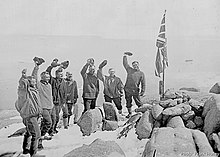British Australian and New Zealand Antarctic Research Expedition

The British Australian (and) New Zealand Antarctic Research Expedition ( BANZARE ) was a research expedition to Antarctica that was conducted between 1929 and 1931 and included two voyages in consecutive Antarctic summers. It was a Commonwealth expedition that was motivated by geopolitics rather than science. It was funded by the United Kingdom , Australia and New Zealand .
The head of the BANZARE was Sir Douglas Mawson . There were various sub-leaders (Captain Kenneth Norman MacKenzie (1897-1951) replaced Captain John King Davis in the second summer) on board the RRS Discovery , the ship that had previously been used by Robert Falcon Scott . The BANZARE, which also made several flights in a small plane, mapped the coast of Antarctica , gave the Banzare coast its name, and discovered Mac Robertson Land and Princess Elizabeth Land (which were later incorporated into the Australian Antarctic Territory ).
The expedition was a "profit-oriented exploration expedition", with Mawson proclaiming British sovereignty for every land sighting - with the agreement that the territory would later be transferred to Australia (happened in 1933). Such a proclamation was made on January 5, 1931 at Cape Denison , where Mawson's Australasian Antarctic Expedition 1912/13 was based.
However, the BANZARE also conducted scientific research and produced thirteen volumes of reports on geology, oceanography, meteorology, geomagnetism, zoology and botany between 1937 and 1975.